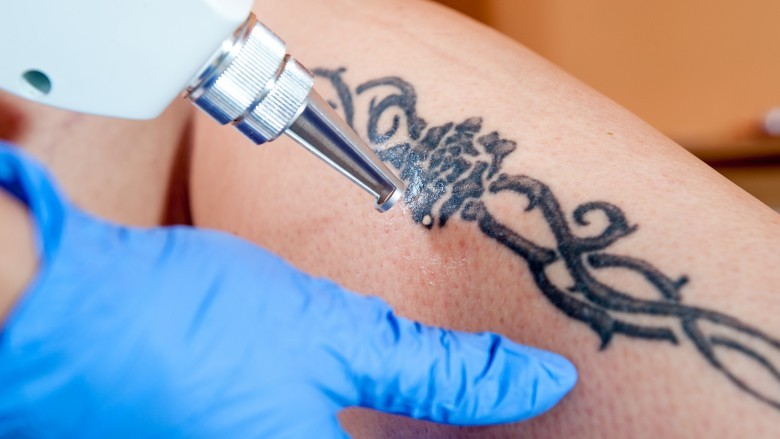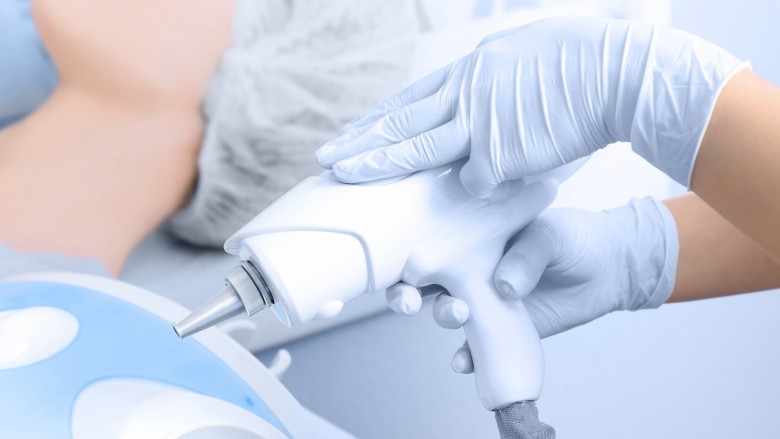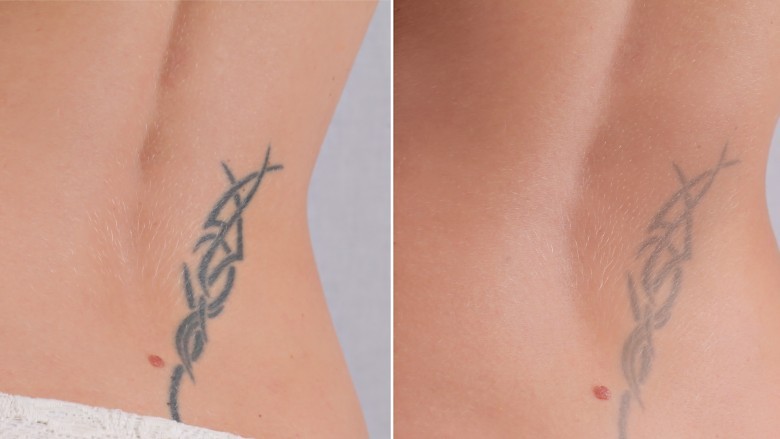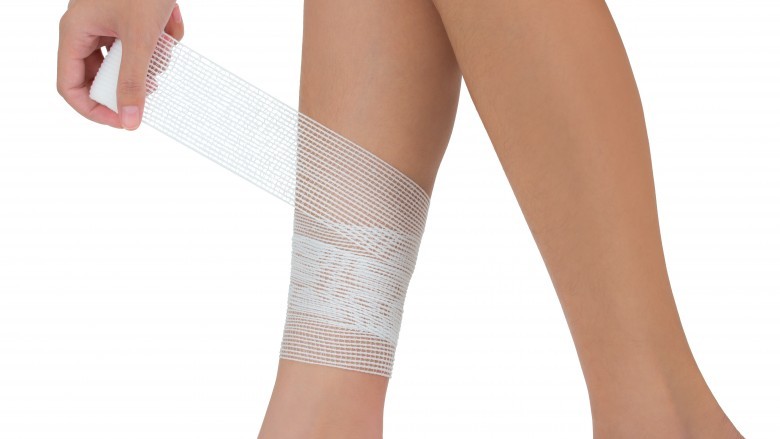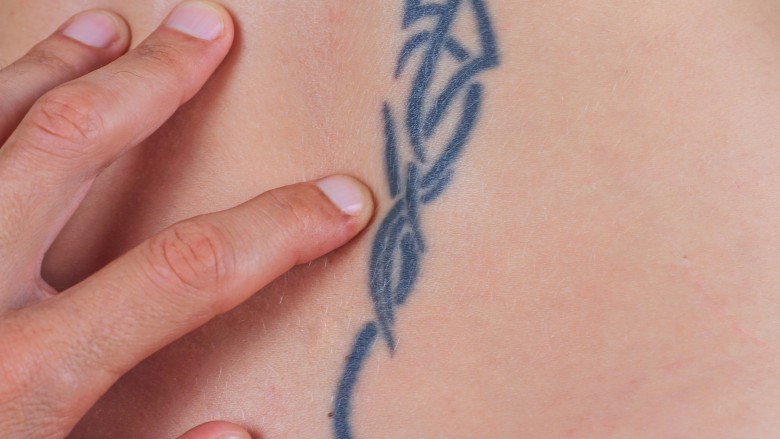Everything You Need To Know About Tattoo Removal
Tattoos have been around for millennia, with the oldest tattoos on record coming from more than 5,000 years ago.
The stigma of having and getting tattoos seems to have dissipated in the last decade or so, bringing tattoos into mainstream culture. Over the years, a lot more of my friends (myself included) have gotten at least one tattoo. Some people caution against getting a tattoo because it's permanent. However, with the advancement of technology, tattoo removal is not only becoming more effective, but a lot more accessible and affordable. So now, if you want to get rid of that questionable tattoo from your teens, or perhaps you just want to get rid of an old tattoo to make room for a new one, you actually have the option to do so.
But before you book your appointment, you should probably know what you're getting into.
How exactly does tattoo removal work?
The basic definition of how tattoo removal works, according to Dr. Omar Ibrahimi of the Connecticut Skin Institute, is that a laser is used to break up tattoo ink particles. "Some of the ink comes through the surface of the skin, and the ink that remains in the skin is broken into smaller and smaller pieces, and with a series of treatments the particles become broken up enough until they are no longer visible," he tells me.
A more technical explanation of traditional laser tattoo removal, as NYC-based dermatoligist Dr. Jeremy Brauer explains, is it "works by employing a theory known as selective photothermolysis." Photothermolysis states that when the appropriate wavelength of light and pulse duration are used to target the tattoo, it will heat the target to the point of destruction (a photothermal effect) with minimal damage to surrounding skin. More recently, he tells me, "it has been shown that picosecond pulse duration lasers remove tattoos by a photomechanical effect as well, physically fracturing the tattoo particles. These smaller particles are then removed by the body."
There's more than one way to remove a tattoo
Laser tattoo removal is the most popular method to remove a tattoo. Occasionally, tattoos can be surgically removed. "Prior to the availability of lasers," says Dr. Ibrahimi, "many attempts at using chemical peels or dermabrasion were used but were associated with very high rates of scarring and other unwanted side effects."
Specific to laser tattoo removal, however, Dr. Brauer says that several techniques or methods exist. These include "combining treatment with lasers traditionally used for resurfacing (treatment of fine lines, sun damage, scarring, etc.), repeating treatment every 20 minutes (approximately the time required) after epidermal whitening subsides during one office visit, and the use of a DeScribe PFD Patch that allows for even more rapid resolution of that whitening (seconds to minutes) and subsequent multiple passes in the same visit."
When you go in for your tattoo removal consultation, your doctor will be able to discuss the appropriate options for removing your tattoo.
How many sessions before a tattoo is completely removed?
Dr. Ibrahimi tells me that traditionally, with a nanosecond laser, it would take between 10-20 treatments for tattoo removal, and there is always a possibility that results could be less than satisfactory. However, you should know that there are many factors that can affect how a tattoo will respond to laser treatment. These factors can include "the age of the tattoo, how it was placed (professional vs. amateur), the body location, and ink color, to name a few," says Dr. Brauer. "In my practice we use the DeScribe PFD Patch along with laser tattoo treatments, which can help decrease the number of treatments needed."
"We are generally getting tattoos removed in around six treatments," says Dr. Ibrahimi, who uses something called an Enlighten laser. "This has revolutionized my tattoo removal practice."
The process differs depending on your tattoo
Consulting with a physician or dermatalogist before you go in and have tattoos removed is necessary because your procedure could differ from someone else's. Just because you've heard from a friend that their tattoo was completely erased after two sessions, that doesn't mean it will be the same way for you. In fact, how many sessions you're going to need to completely remove a tattoo can even depend on what color it is. "Black tattoos used to be amongst the easiest colors to treat with traditional tattoo removal lasers (nanosecond)," says Dr. Brauer. "However, now with newer picosecond lasers, blue and green colored tattoos have become amongst the easiest."
He also says that it is very important to minimize the risk of scarring and "unwanted change in pigmentation," so you need to make sure that the area you want to be treated "has not been exposed to sun prior to treatment or subsequent to treatment during healing."
This might sting a little
You've already gotten a tattoo before, so this probably won't be a big deal, but tattoo removal isn't entirely pain-free.
Tattoo removal is uncomfortable, but Dr. Ibrahimi says that there are many methods to minimize the pain. "Numbing cream and ice can lessen the pain of the laser," he says, "if the tattoo is small enough."
You should also keep in mind that the placement of your tattoo could determine how much pain and discomfort you may feel. "We certainly have parts of the body that are more sensitive," says Dr. Brauer. So in cases where you may experience more pain, "local anesthetic is used such that the treatment itself should be painless." It might be a relief to know that the treatments themselves may not be painful, but you could experience some discomfort afterwards as well.
What to expect once your tattoo is removed
After treatment, it is normal to expect the area to be "red, swollen, and bruised," says Dr. Brauer. "One can also experience blistering and crusting." He strongly encourages the regular application of an ointment like Aquaphor and using bandages until the treatment area is fully healed.
Now, if you want your tattoo(s) removed for a cleaner cover up, or perhaps you've just changed your mind and want something different, you'll have to wait a while before getting inked again. Many patients want to lighten their tattoo enough so they could get a cover up, or the original tattoo did not come out the way they intended and they want to get another shot at having it look the way they envisioned it, according to Dr. Ibrahimi. "Generally speaking, once the skin heals from the acute effects of laser, it is safe to re-tattoo," he says. "This typically take one to four weeks depending on the area of the body the tattoo is located on."
Tattoo removal isn't risk-free
Like most medical procedures, tattoo removal isn't without its own set of risks.
It is very important that you seek out treatment with a board certified dermatologist or physician with formal training in lasers before you get tattoo removal done. "Risks can include, but are not limited to, scarring and unintended permanent change in color — lightening or darkening of the skin," says Dr. Brauer. "It is extremely important that the appropriate laser wavelength and pulse durations are selected, but also that the laser treatment is performed appropriately."
You could also be advised against tattoo removal all together. "There are in fact medical conditions and even certain medications or history of certain treatments that would preclude one from treatment," he says. "Safe treatment of individuals of all skin types is possible, but appropriate laser, parameters, and technique is required to minimize the greater risk of adverse events in those individuals."
Tattoo removal is going to cost you
If you think that getting a tattoo is no big deal because you can have it removed at any time, you're not incorrect. However, even with its growing popularity, tattoo removal still hasn't exactly reached bargain prices. Depending on a number of factors, tattoo removal can cost you you between $200-$500 per treatment session. That's a lot of money to remove a tattoo that probably cost a mere fraction of the price. It might still be a good idea to give your tattoo design some serious thought before you get it.
Think before you get un-inked
Just as you should with getting a tattoo, it's important to consider all of your options if you're thinking of getting a tattoo removed. Do your research and seek consultations with different clinics and doctors before you go in for a procedure. Remember, tattoo removal can be costly and time-consuming, so if you're getting it done, you should get it done safely and correctly.
